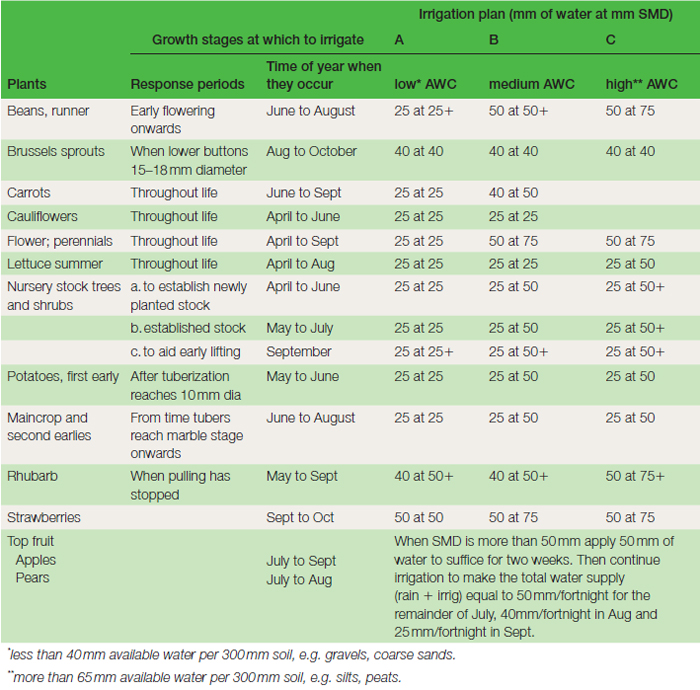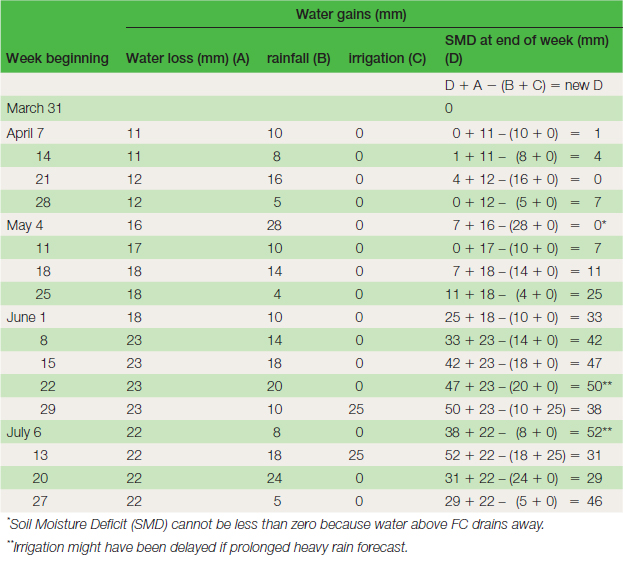Irrigation
Content
Irrigation should be seen as a husbandry aid in addition to otherwise sound practice. It is assumed in the following that water is being added to a well-drained soil. The need for irrigation depends mainly on available water in the rooting zone and the effect of water stress on the plant’s stage of growth. The very large quantities of water required for commercial production are illustrated clearly in the estimates for growing in protected culture, where all the requirements have to be delivered to the crop by irrigation. In the British Isles, the daily consumption of water from a full cover crop, such as tomatoes or cucumbers, is about 20 000 litres per hectare in March rising to double that in June. This amounts to about 9000 cubic metres per year (approximately 750 000 gallons per acre). A more exact estimate can be obtained by measuring the light levels outside the greenhouse; 2200 litres per hectare are required for each megajoule per square metre. This can be compared with the 6000 cubic metres of rainfall that could be collected, on average, from the roof of a hectare of glass in the south-east of England. To take advantage of this contribution there would need to be substantial storage facilities and the water quality issues would need to be addressed. Response periods are the growth stages when the use of irrigation during periods of rainfall deficiency is likely to be worthwhile. In general all plants benefit from moist seedbeds and eliminating water stress maximizes vegetative growth. Initiation of fl owering and fruiting is favoured by drier conditions. The response periods of a range of plants grown in the UK is given in Table 19.3. Irrigation plans In general, water should not be added to outdoor soils until moisture levels fall to 50 per cent of available water content in the rooting zone. Outdoors 25 mm of water is the minimum that should be added at any one time in order to reduce the frequency of irrigation, to reduce water loss by evaporation and to prevent the development of shallow rooting. On most soils the amount of water added should be such as to return the soil to field capacity. Addition of water to clays and clay loams should be minimized so as not to reduce the vital drying and wetting cycles, and if they have to be irrigated they should not be returned to field capacity in case rain follows (see ponding). Irrigation should never result in fertilizers being leached from the rooting depth unless it is the specific objective, as in flooding of greenhouse soils (see conductivity). Most recommendations are given in a simplified form taking the above points into account. The recommended plan is usually expressed in terms of how much water to apply, at a given soil moisture deficit, for a named crop on a soil of stated available water content. Thus for an outdoor grown summer lettuce crop grown on soils of a medium available water content, 25 mm of water should be added when a 25 mm soil moisture deficit occurs. This would require the application of 250 000 litres per hectare or 25 litres per square metre. Further examples are given in Table 19.3. Soil moisture deficit (SMD) can be calculated by keeping a soil water balance sheet. The account is conveniently started after rain returns the soil to field capacity, i.e. when SMD is zero. In Britain it is assumed that, unless it has been a dry winter, the soil is at field capacity until the end of March. From the first day of April a dayby- day check can be made of water gains and losses. A worked example of a weekly water balance sheet is given in Table 19.4; a daily water balance sheet may be more appropriate in some situations.
Rainfall varies greatly from year to year from one locality to the next and so it should be determined on site (see rain-gauge) or obtained from a local weather station. Water loss for each month does not vary very much over the years and so potential transpiration rates based on past records can be used in the calculation. There are potential transpiration rate figures available for all localities having weather stations. Examples are given in Table 19.2. These figures can be used when calculating water loss, but until there is 20 per cent leaf canopy a maximum SMD of 20 mm is not exceeded because in the early stages water loss is predominantly from the soil surface by evaporation. In protected cropping all the water that plants require has to be supplied by the grower, who must therefore have complete control over irrigation. With experience the grower can determine water requirements by examining plants, soil, root balls or by tapping pots. A tensiometer can be used to indicate the soil water tension but, while this is useful to indicate when to water, it does not show directly how much water is needed. Evaporimeters distributed through the planting can give the water requirement by showing how much water has been evaporated. A solarimeter measures the total radiation received from the sun and the readings obtained can be used to calculate water losses, often expressed in litres per square metre for convenience. Methods of applying water These should be carefully related to plant requirements, climate and soil type. On a small scale, watering cans or hoses fitted with trigger lances can be used, but care should be taken to avoid damaging the structure of the growing medium. Water can be sprayed from fixed or mobile equipment, but it is essential that the rate of application is related to soil infiltration rate The droplet size in the spray should not be large enough to damage the surface structure (see tilth). Indoors, spray lines can be fitted with nozzles to control the direction and quantity of water. Overhead lines can lead to very high humidity levels and wet foliage, predisposing some plants to disease (see grey mould). Consequently, it should be restricted to watering low level crops, e.g. lettuce, deliberately increasing humidity (‘damping down’ or ‘spraying over’), or winter fl ooding (see conductivity). Trickle lines deliver water very slowly to the soil, leaving plant foliage and the soil surface dry, which ensures a drier atmosphere and reduced water loss. However, care is needed because there is very little sideways spread of water into coarse sand, loose soil, or a growing medium that has completely dried out. Drip irrigation is a variation on the trickle method, but the water is applied through pegged down thin, flexible ‘spaghetti’ tubes to exactly where it is needed, e.g. in each pot or at the base of each plant. Simple flooded benches are sometimes used to water pot plants. The shallow tray of the benched area is filled with water which the pots absorb, after which the excess water is drained off (‘ebb and flow’). This tends to produce a high humidity around the plants and capillary benches have come to be preferred. The pots stand on, and the contents make contact with, a level 50 mm bed of sand kept saturated at the base by an automatic water supply. Water lost by evaporation at the surface and from the plant is replaced by capillary rise. The sand must be fine enough to lift the water but coarse enough to ensure that the fl ow rate is sufficient. Capillary matting made of fibre woven to a thickness and pore size to hold, distribute and/or lift water has many uses in watering containerized crops both indoors and outside. Containers with built-in water reserves and easy watering systems utilize capillarity to keep the rooting zone moist. Sub-irrigated sand beds are used for standing out container plants in nursery production and are less wasteful of water than the more usual overhead spray lines. |
|||||||||||||||||||||||||






